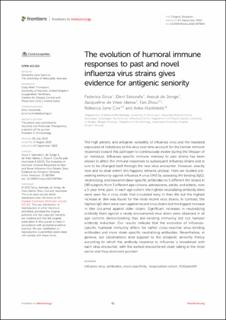| dc.contributor.author | Sicca, Federica | |
| dc.contributor.author | Sakorafa, Eleni | |
| dc.contributor.author | de Jonge, Anouk | |
| dc.contributor.author | de Vries-Idema, Jacqueline | |
| dc.contributor.author | Zhou, Fan | |
| dc.contributor.author | Cox, Rebecca Jane | |
| dc.contributor.author | Huckriede, Anke | |
| dc.date.accessioned | 2023-01-11T14:01:13Z | |
| dc.date.available | 2023-01-11T14:01:13Z | |
| dc.date.created | 2022-11-01T09:08:18Z | |
| dc.date.issued | 2022 | |
| dc.identifier.issn | 1664-3224 | |
| dc.identifier.uri | https://hdl.handle.net/11250/3042762 | |
| dc.description.abstract | The high genetic and antigenic variability of influenza virus and the repeated exposures of individuals to the virus over time account for the human immune responses toward this pathogen to continuously evolve during the lifespan of an individual. Influenza-specific immune memory to past strains has been shown to affect the immune responses to subsequent influenza strains and in turn to be changed itself through the new virus encounter. However, exactly how and to what extent this happens remains unclear. Here we studied pre-existing immunity against influenza A virus (IAV) by assessing IAV binding (IgG), neutralizing, and neuraminidase-specific antibodies to 5 different IAV strains in 180 subjects from 3 different age cohorts, adolescents, adults, and elderly, over a 5-year time span. In each age cohort, the highest neutralizing antibody titers were seen for a virus strain that circulated early in their life but the highest increase in titer was found for the most recent virus strains. In contrast, the highest IgG titers were seen against recent virus strains but the biggest increase in titer occurred against older strains. Significant increases in neutralizing antibody titers against a newly encountered virus strain were observed in all age cohorts demonstrating that pre-existing immunity did not hamper antibody induction. Our results indicate that the evolution of influenza-specific humoral immunity differs for rather cross-reactive virus-binding antibodies and more strain-specific neutralizing antibodies. Nevertheless, in general, our observations lend support to the antigenic seniority theory according to which the antibody response to influenza is broadened with each virus encounter, with the earliest encountered strain taking in the most senior and thus dominant position. | en_US |
| dc.language.iso | eng | en_US |
| dc.publisher | Frontiers | en_US |
| dc.rights | Navngivelse 4.0 Internasjonal | * |
| dc.rights.uri | http://creativecommons.org/licenses/by/4.0/deed.no | * |
| dc.title | The evolution of humoral immune responses to past and novel influenza virus strains gives evidence for antigenic seniority | en_US |
| dc.type | Journal article | en_US |
| dc.type | Peer reviewed | en_US |
| dc.description.version | publishedVersion | en_US |
| dc.rights.holder | Copyright 2022 The Author(s) | en_US |
| dc.source.articlenumber | 987984 | en_US |
| cristin.ispublished | true | |
| cristin.fulltext | original | |
| cristin.qualitycode | 1 | |
| dc.identifier.doi | 10.3389/fimmu.2022.987984 | |
| dc.identifier.cristin | 2067143 | |
| dc.source.journal | Frontiers in Immunology | en_US |
| dc.relation.project | EU – Horisont Europa (EC/HEU): 284930 | en_US |
| dc.identifier.citation | Frontiers in Immunology. 2022, 13, 987984. | en_US |
| dc.source.volume | 13 | en_US |

